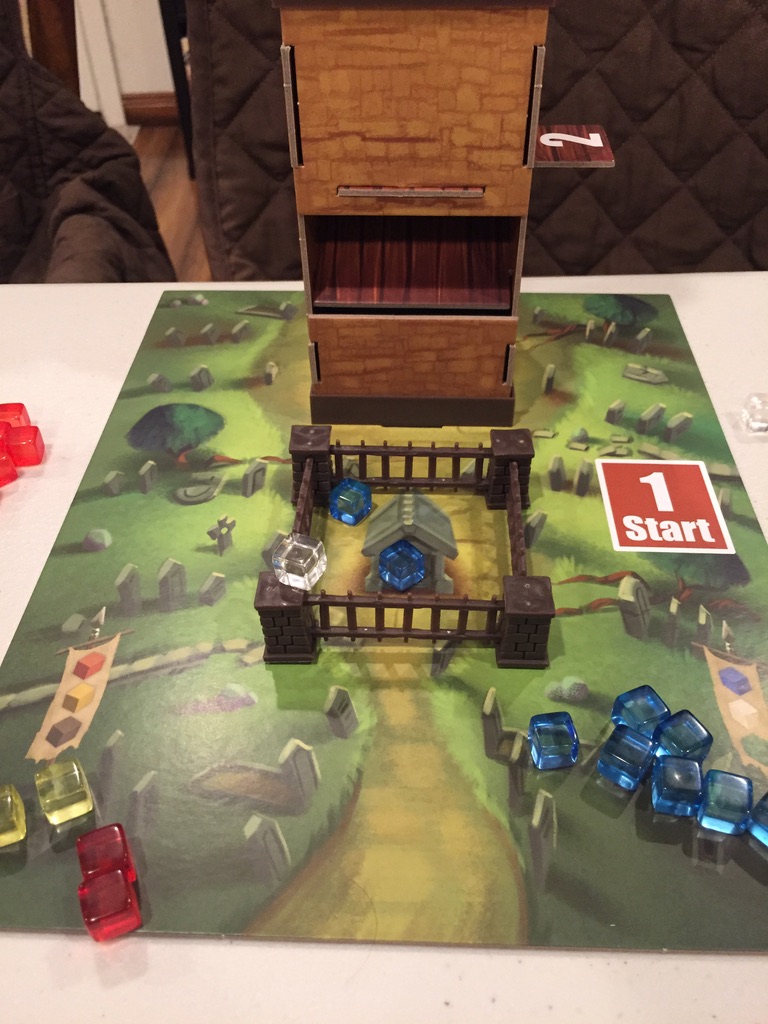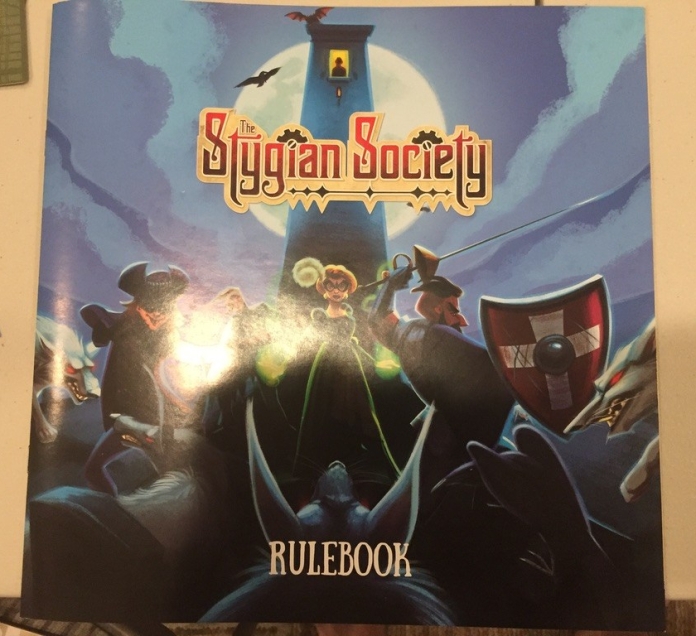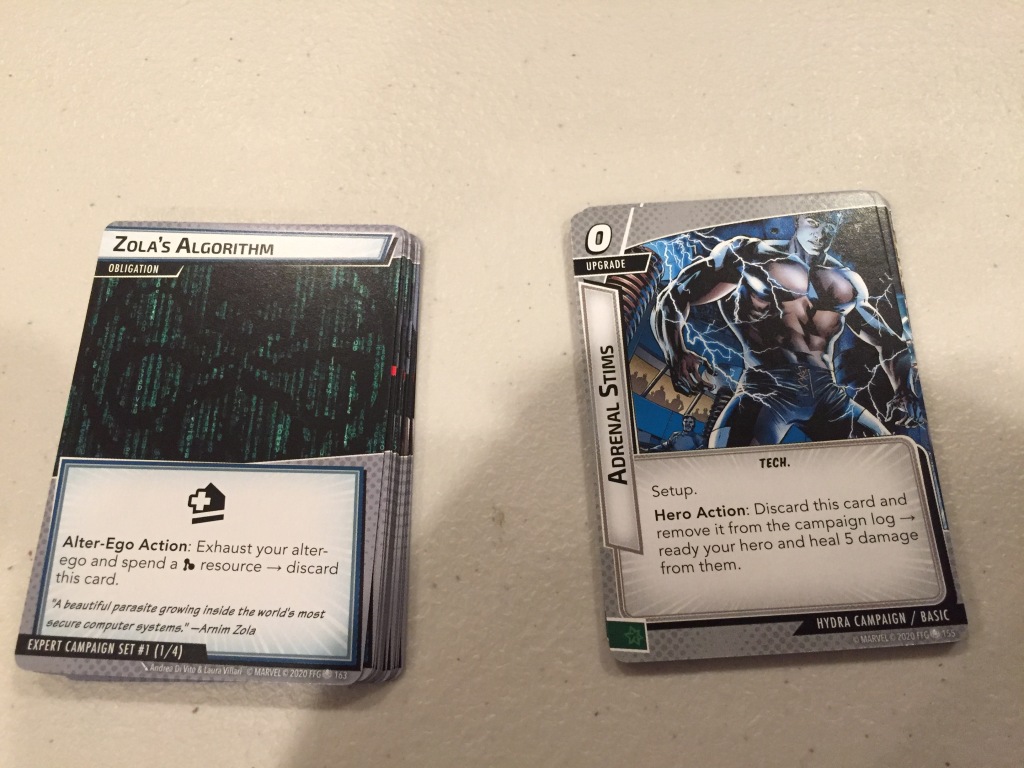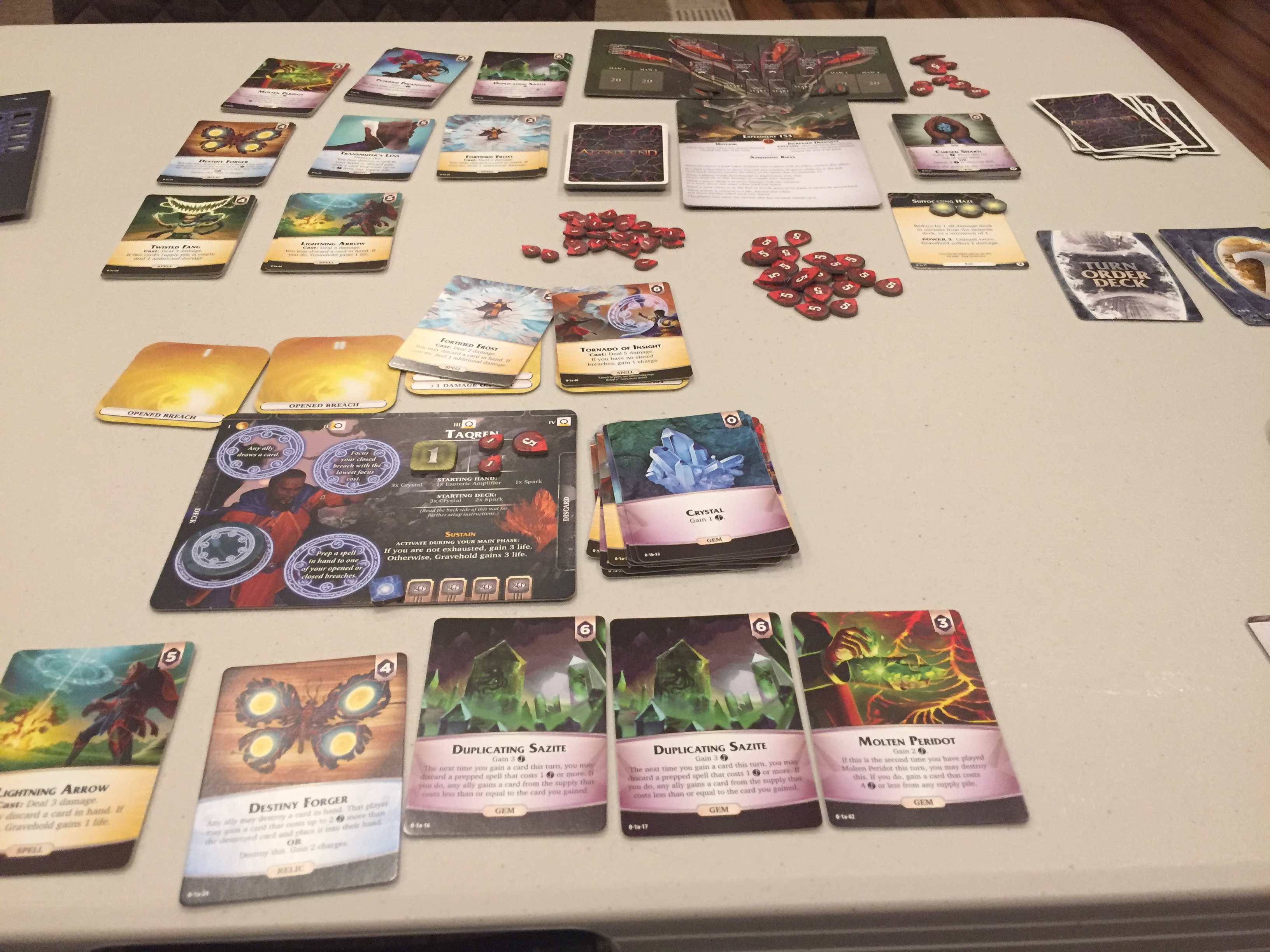
The Stygian Society is a Kickstarter game that arrived Friday, September 25th, 2020. This is a cooperative, exploration game where the cube tower is center stage.

This is a game by Kevin Wilson, one of the developers/designers of Arkham Horror, Second Edition (along with Richard Lanius). Arkham Horror, Second Edition is a favorite game around my gaming table (it comes out every Halloween), so Kevin Wilson’s name evokes a good feeling! That’s why I Kickstarted this!
The Game

So, the game delivered from Ookoodook (which longtime readers of the Order of the Stick may recognize as OOTS’ delivery company). This actually seems very apropos: The Stygian Society game is “essentially” a dungeon delver, where players explore dungeons, fight monsters, get treasures … just like Order of the Stick.

You’ll notice the Kickstarter version comes with a slipcover (notice the black cover above). Do they really protect games? I don’t know. It’s seem cool because it’s premium, but are slipcovers really useful?
Components

This is a BIG game. The game has lots of components. The game comes with a fairly extensive backstory (see above) that you don’t need to play the game, but it adds to the theme.
The board is where most of the action will take place: it’s where cubes will be and most importantly, the cube tower.
The most important thing in the game is the cube tower: you can see the directions for building it, and they are a little daunting.
The parts for the cube tower are just underneath and are heavy cardboard punchouts.
The status board (see above) allows the players to track experience, party health, default actions, luck, peril, and treasure. It seems fairly confusing at first, but it quickly becomes easy to figure out.

Every player takes the role of a character, and each character has a unique deck of “abilities” that’s just theirs. Each player starts with a level 1 power and can add a new ability as you level up (see experience tracker from the status board above).

Like many dungeon delving (tower climbing) games, there is a Big Bad Boss (the Wizard: dark purple boards) you fight at the end of the game: to win, you must make it to the top level and fight the Big Bad Boss. Interestingly, there is is a “mid level” baddie you fight halfway through the game (the light purpose boards).
In between the Wizard at the end, and the mid-level Boss, you will be fighting lesser bad guys on the lower levels of the tower. The little plastic miniatures represent the bad guys you fight.
The tower is divided into 6 levels:2 lower levels, the mid-level big bad, 2 upper levels, and the Wizard (big bad boss). The lower levels are represented the by the light purple cards (see above) and the upper levels are represented by the dark purple cards (see above).
There’s a lot of cards: treasure cards (above left), status cards (above), and chest traps cards (above right). The cards are nice and readable, but there’s not a lot of art: the only cards that really have unique art are the treasure cards. The cards aren’t linen finished, but they are nice enough.

In general, the components are nice. The cards could be nicer, but there is a lot of heavy cardboard. If I were to make one change, I would have made the cards linen-finished.
The Elephant in the Room: The Cube Tower

Normally, the first thing I do it start looking at the rulebook. Nope! The first thing I expect EVERYONE to do first is start building the cube tower. The directions are … okay. I had to really look to see “exactly” what pieces go where.
There were a lot of pieces, a lot of plastic, and a lot of cardboard.

But, in the end, it went together. It was generally “fun” to build the tower, but I wish it had “another pass” to the directions. Eh, they were good enough.

The final result: The tower! Where Cubes Go! The crypt! Where some cubes will fall! The field! Where most of the rest of the cubes will fall! I gotta admit, it looks pretty cool. It fit together pretty well and it seems pretty sturdy. (It even goes back into the box all made!!)
Oh, in case you’ve never played with a cube tower, one of the reasons they are kind of cool: YOU THROW CUBES IN THE TOWER! It’s a cool kinesthetic experience!! Cubes fall through the tower, making noise!!! And even cooler: SOMETIMES CUBES GET STUCK IN THE TOWER AND DO NOT COME OUT UNTIL LATER! There is some “history” left in the tower! You throw cubes in a tower (fun) and occasionally, you get some leftover cubes from the previous turn (funner)! It’s a gimmick. But it’s a FUN gimmick!
The Rulebook
So, after building the cube tower … boy, that cube tower looks cool … oh, sorry … The rulebook!
The rulebook is about what you expect these days: the first few pages show the main components (above for cube tower and below for cards and boards).

The game shows set-up mid book:

The set-up works pretty good. Once you leave this section, the game is pretty text-heavy: there’s not a lot of pictures afterwards. It works … fine. I had several rules questions as I played, and I missed a bunch of things as I played the first few times. There’s no index, but you can “usually” find what you need. The rules are “just enough” to play, but not much more. There are some issues:
- How is Luck used? Answer: it’s hard to find: it’s buried in a picture in the first few pages when it talks about the status board. That was the only place I found that talked about luck!
- What do you reset? Answer: it’s kind of split into two pieces “entering a floor” and “exiting a floor”. Answer: you reset peril, and clean the field and crypt but NOT party health and NOT the cube tower!! It wasn’t clear: the game could have really used a reference card.
- Status questions: Answer: take your best guess.
The game rulebook is … complete, but an index OR a game summary cards would gone a long way. Look, I have seen a lot of terrible rulebooks, and this is not one of them. The answers are all in there, it just needed another “push”. I got through it, I never even really raised my voice, but I was slightly frustrated at a few points.
The rulebook is fine.
Solo Game

So, the game works great solo: you can see they absolutely have solo rules (thank you for adhering to Saunders’ Law)! In this case, the solo player plays 3 characters from the game.

I played the Knight, the Burglar, and the Doctor for my first solo game. Although I am nervous about playing three distinct characters as a solo player (“Yikes! is there too much to manage?”), it worked fine. Each character describes its rules succinctly, and was easy to manage. The solo rules worked well. There is a way to play just two characters (outlined on the very back on the rulebook), but it involved changing enough rules that I prefer to play the main rules so I don’t have to apply too many exceptions.
It looks like main balancing for the game is that there should always be 3 or 4 characters in play: the rulebook alludes to the players needing the balance and cooperation of numerous players to win. And you know what? I needed all three of my characters to win! I needed the knight to do most of the damage, I neede the Burglar to help keep bad cubes under control, and the doctor to heal us … at one point, our party wounds were so bad, we almost lost before the end! As any veteran of D&D knows, the cleric (the doctor here) is critical to party success!
Set-Up and Gameplay
So, set-up wasn’t trivial. I had to do it in two stages: get most of the components OUT (see above) and then actually put them in the right place (see below)!
The gameplay is actually pretty simple. Each character plays a turn and that’s it! There’s no notion of Bad News (typically in a cooperative game) or the “Bad Guy turn”, as the Bad Guys are activated by the BAD cubes that come out of the tower! A character turn looks like:
- Pick a support ability
- Choose an active action (usually puts GOOD cubes in the tower)
- Throw GOOD cubes and BAD cubes into the tower (your current location in the tower tells you how many BAD cubes to put in)
- Activate the Bad Guys based on how many BAD cubes are out (activate rooms if cubes left over)
- Activate character abilities using GOOD cubes

Basically, BLUE, WHITE, and GREEN cubes are good cubes used by the characters. The RED, YELLOW, and BLACK cubes trigger Bad Guys abilities. Cubes that land in the crypt (the white cube above) are worth 2, everything in the field is worth 1 (the blue, red, yellow cubes above, just behind the crypt).

An example mid-level Bad Guy (see above, blurred so can’t see too much). Note that there are bad guys in the front row (2 yellows and 1 red) and the back row (2 yellows). When enough cubes are one the board (note the 5 red cubes), then you spend those red cubes from the board and activate that power! The game is all about bad cubes accumulating and just trouncing you now and then!!
See above for another example (from a low-level floor).

Overall
See above for my winning game!
In general, I really liked this game. I got to make decisions every turn that mattered: What support cards do I use? Do I need to mitigate the BAD cubes? Do I need to put in cubes to help my next character? Which action do I activate? Do I use one of my treasures? Then, I got to throw cubes in a tower! Whee! Arguably, the only “not fun” part was following the script to make the BAD cubes activate the bad guys: it’s necessary of course, but it’s ever so slightly tedious.

One of the best parts of the game was that we leveled up quickly!! It seems like we leveled up just about every floor of the tower!! Leveling up allows you to reset your support cards (cards gets tapped and can only be reset when you go up a level), and you get to add a new “more powerful” ability!!! It gives you new and better decisions to make!!! And the treasure was useful too!!!

The only thing that mighty give me pause to recommending it to others was the length of the game. It took me an hour to set-up (first time, also had to build the cube tower), about about 2 hours to reach and defeat the Mid Level Boss, and another 2 hours to reach and defeat the final boss!! I am sure this will probably become much quicker when we play again, but I am not sure. I like taking my time and making good decisions (I did win my first game), but the game length might be a bit much for other people.
Conclusion
The game flowed quickly when I played. There were some moments when I really thought I might lose, but I had enough choices so I could make meaningful decisions to “not die”! I was able to upgrade myself multiple times during play, so I felt like I was always making progress!! There are a few fiddly moments in the game (status updating, updating the bad Guys), but there were overwhelmingly more fun moments of throwing cubes and making fun choices!
As a solo experience, this was great. I look forward to playing solo again! I’m also hoping to get Part II of this review out soon: I really want to see how this will work with multiple players cooperating! Expect Part II soon! I was so very happy this game, I will “encourage” my game groups to play this with me!
There’s even some expansion content to keep the game fresh! (See The Tower Laboratory expansion above).























:strip_icc()/pic4154118.jpg)
:strip_icc()/pic1534148.jpg)


























:strip_icc()/pic5182494.jpg)











